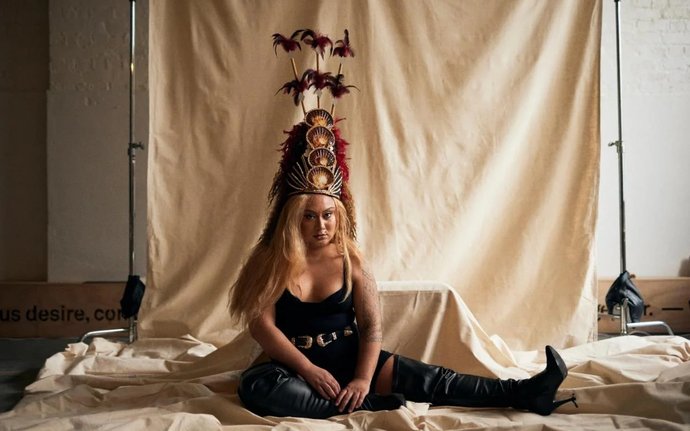Resident artist ready to inspire: Moe Laga
4 Jun 2024, André Chumko, The Post
This article first appeared in The Post, 4 June 2024

This article first appeared in The Post, 4 June 2024

Moe Laga, an interdisciplinary artist from Tāmaki Makaurau whose practice includes movement, activation and storytelling, has been selected as the Aniva Arts resident for 2024 based at Pātaka Art + Museum.
Laga has more than 10 years of experience as an artist. Her works include a number of stage and screen productions varying from experimental to professional, as well as collaborative visual arts work that has been shown in Australia, Switzerland and Germany, as well as the Pingyao International Photography Festival in China.
Laga, who identifies as fa’afafine, is a part of the award winning queer arts collective FAFSWAG, and is the creative director for the COVEN arts collective and the overall ‘mother’ of the ballroom house Coven-Aucoin. Laga is also a queer activist and leader in the Pasifika rainbow community, advocating for trans visibility and social mobility.
What does it mean to you to be part of FAFSWAG?
Being a part of FAFSWAG saved my life. For me FAFSWAG is my chosen family that has supported my journey through my queerness and my art practice for over a decade. They have given me permission to live my truth unapologetically. I am forever grateful for the community/chosen family that they built.

How do you plan to spend your residency in Porirua?
I am honoured to have been awarded this residency, it’s pretty much my first solo residency, and to have it in Porirua makes it even more exciting. The majority of my father's family is based in Porirua, and I’m excited to make that connection. I look forward to spending time with the MVPFAFF (Pasifika queer) community and the ballroom community in Pōneke and just soak in all the goodness and feel inspired.
How is the art of ballroom changing in Aotearoa?
The ballroom scene (an underground drag culture of dance) is evolving and changing in several ways. One significant aspect is the increasing visibility and recognition of diverse voices within the ballroom scene. There is a growing emphasis on inclusivity, with efforts to create safer spaces for LGBTQIA+ individuals, especially those from marginalised communities.
There’s a shift towards incorporating elements of traditional Māori and Pacific culture into ballroom performances, creating a unique fusion that celebrates the rich cultural heritage of Aotearoa. This intersectionality adds depth and authenticity to the art form, providing a platform for artists to express their identities and stories in new and meaningful ways.
There’s also greater emphasis on activism and social change within the ballroom community. Artists are using their platforms to address important issues such as racism, homophobia, transphobia, and gender identity.
And what about voguing?
The language of vogue is evolving and becoming different with every generation that is coming through and being inspired by the art form. When the ballroom scene started here in Aotearoa, many of us saw vogue as a lifestyle to help us with our every day survival.
Who are some of your biggest artistic inspirations?
I draw inspiration from a variety of artists, particularly those who have paved their way and created their own paths. They include Lindah Lepou, Rosanna Raymond, Jahra Wasasala, Lady Shaka, Ramon Te Wake, Parris Goebel, Tanu Gago, Cindy of Samoa, Yuki Kihara, Jaycee Tanuvasa, and Phylesha Brown-Acton. These artists are world builders and have left a lasting impact on me.
The CNZ Aniva Residency is a partnership between Creative NZ and Pātaka Art + Museum.